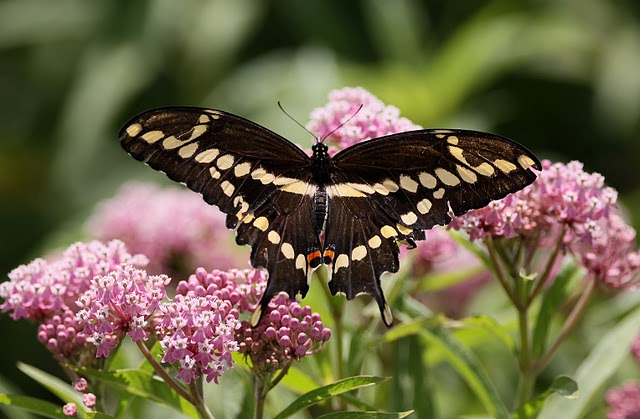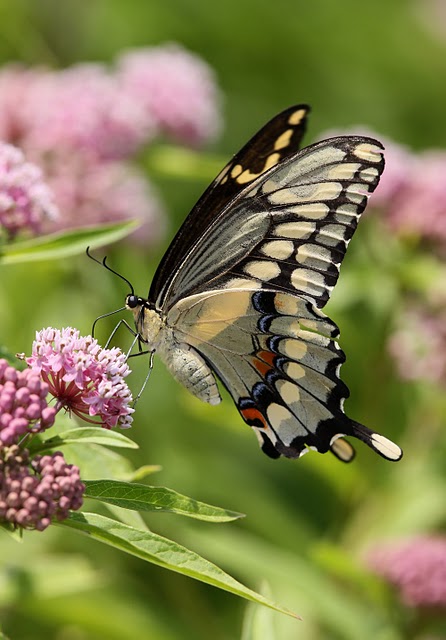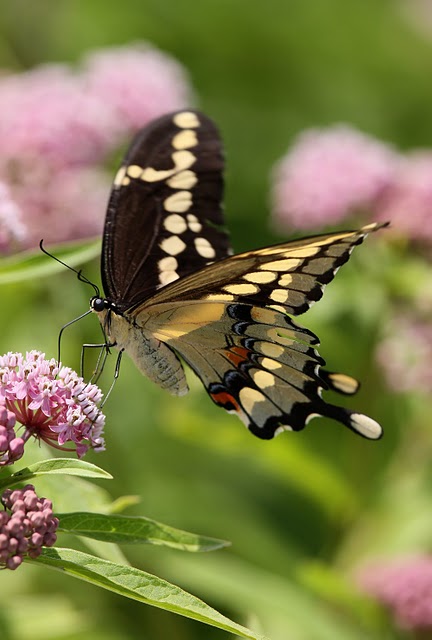|
Introduction
The giant swallowtail, Papilio cresphontes Cramer, is a striking,
wonderfully "exotic"-looking butterfly that is very abundant
in Florida. The adult butterfly is a welcome visitor to butterfly
gardens and to general landscape plantings. The larval or caterpillar
stage can be considered a pest because of its habit of feeding on
the foliage of most Citrus species. A few "orangedogs",
as the larvae are commonly called, can quickly defoliate small or
young plants. However, larvae can be tolerated on large dooryard
citrus trees in order to enjoy the soon-to-develop magnificent adult
butterfly stage.

Distribution
The giant swallowtail is widely distributed throughout the American
continent. Its range extends from southern New England across the
northern Great Lakes states, into Ontario, through the southern
portions of the Central Plains to the Rocky Mountains. The species
ranges southward to Florida and the Caribbean, into the southwestern
United States, and on through Mexico to Central and South America.
The giant swallowtail is very common throughout the entire state
of Florida. It is active throughout the year in southern Florida,
and is common in northern Florida, except in January and February.
 Description Description
Adult giant swallowtails are large butterflies with a forewing span
of 4.6 to 6.9 inches (avg. 5.5 inches) for males and a span of 5.3
to 7.4 inches (avg. 5.8 inches) for females. The dorsal wing surfaces
of the butterfly are black with a striking diagonal yellow bar across
the forewings. The ventral wing surfaces are primarily yellow. The
giant swallowtail is very distinct from all other swallowtails found
in Florida, except for the endangered Schaus' swallowtail (Papilio
aristodemus ponceanus) which is confined to the Florida Keys. The
giant swallowtail can be distinguished from the Schaus' swallowtail
by the yellow-filled "tails" (Schaus' swallowtail tails
are all black), and the small, brick-red patch just interior to
the blue median band on the ventral hind wing. The five larval instars
differ in appearance but they all share a resemblance to bird droppings.
The younger instars are predominantly black with a white saddle
while the older instars are mottled dark brown with a posterior
that is white or cream colored. It has been suggested that the older
instars resemble small snakes.
Life
Cycle
Adult butterflies sip nectar from many flowers and are common, but
spectacular, visitors to butterfly gardens. Identified nectar sources
include azalea, bougainvillea, Japanese honeysuckle, goldenrod,
dame's rocket, bouncing Bet, and swamp milkweed. They may also sip
liquid from manure. Adult males patrol flyways through pine woods
or citrus groves searching for females. Flight is very strong and
leisurely, and the butterflies may glide long distances between
wing beats. Courtship and copulation occur in the afternoon.
Mated
females usually lay their eggs singly on the upper surface of leaves
of host plants. The 1 to 1.5-mm spherical eggs are cream to brown
and typically have an irregular coating of an orange secretion that
is reminiscent in appearance of orange peel. Larvae progress through
five instars. Larval feeding usually takes place during the night.
Larvae may pupate on small twigs on the host plant on which they
were feeding or they may travel a short distance to a vertically-oriented
structure, such as a fence or other plant. The brownish chrysalis
is typically oriented at 45° to the pupation substrate, its
posterior end attached directly to the substrate and its anterior
end attached via a thin silken thread to the substrate. At least
two, and probably three, generations occur each year in Florida.
Host Plants
The larva is the well-known "orangedog" and is considered
a minor pest of sweet orange, (Citrus × sinensis (L.) Osbeck
(pro sp.). Host plants of the larvae besides sweet orange include
native members of the citrus family (Rutaceae) including northern
pricklyash (Zanthoxylum americanum Mill.), Hercules-club (Zanthoxylum
clava-herculis L.), lime pricklyash (Zanthoxylum fagara [L.] Sarg.),
hoptree (Ptelea trifoliata L.), sea torchwood (Amyris elemifera
L.), Mexican orange (Choisya dumosa [Torr.] A. Gray), and a variety
of exotic Rutaceae including gasplant (Dictamnus albus L.) and white
sapote (Casimiroa edulis Llave & Lex.). Plant names are from
the USDA Plant Database (2009), Wunderlin and Hansen (2003), or
Wunderlin and Hansen (2008).
 Biological
Control Biological
Control
Giant swallowtail pupae are immobile and defenseless against parasitic
insects. Pupae may be parasitized by Lespesia rileyi (Williston),
a tachinid fly; Brachymeria robusta (Cresson), a chalcidid wasp;
and Pteromalus cassotis Walker and Pteromalus vanessae Howard, two
pteromalid wasps. However, the larval stages appear to be more protected
against natural enemies than the pupal stage. Larvae defend themselves
against predators (both insects and vertebrates) and parasitic insects
by being less visible through cryptic coloration and pattern (i.e.,
by resembling bird droppings). In addition, larvae possess an osmeterium,
an orange or reddish Y-shaped eversible gland that is located mid-dorsally
behind the head. When attacked by small predators, the larva extrudes
the gland and attempts to wipe it against the attacker. The osmeterium
of fourth and fifth instars contains a highly noxious, pungent mixture
of chemicals (40:60 mixture of isobutyric acid and 2-methyl butyric
acid) that smells like rancid butter. This glandular secretion is
repellent and toxic to small predators, such as ants and spiders.
Studies have shown that birds are not repelled by these secretions
but still rarely eat giant swallowtail larvae. It is thought that
larvae may also contain internal toxins (obtained from their food
plants)
Other Control Methods
Homeowners may find that just a few larvae of the giant swallowtail
will defoliate small, potted citrus plants. It is recommended that
larvae be hand picked from these small plants so that blossom and
fruit yield are not drastically reduced. Mature commercial citrus
trees can withstand infestation by many larvae. However, nursery
stock and young grove trees can be protected with Bacillus thuringiensis
and synthetic insecticides when necessary, as described in the Florida
Citrus Pest Management Guide for chewing insects.
|





 Description
Description Biological
Control
Biological
Control